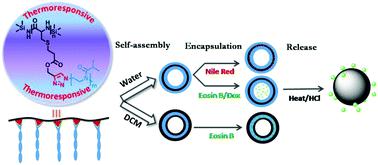当前位置:
X-MOL 学术
›
Polym. Chem.
›
论文详情
Our official English website, www.x-mol.net, welcomes your
feedback! (Note: you will need to create a separate account there.)
Vesicular assemblies of thermoresponsive amphiphilic polypeptide copolymers for guest encapsulation and release
Polymer Chemistry ( IF 4.1 ) Pub Date : 2020-03-19 , DOI: 10.1039/d0py00135j Mahammad Anas 1, 2, 3, 4 , Somdeb Jana 1, 2, 3, 4 , Tarun K. Mandal 1, 2, 3, 4
Polymer Chemistry ( IF 4.1 ) Pub Date : 2020-03-19 , DOI: 10.1039/d0py00135j Mahammad Anas 1, 2, 3, 4 , Somdeb Jana 1, 2, 3, 4 , Tarun K. Mandal 1, 2, 3, 4
Affiliation

|
Synthetic polypeptides are bio-inspired materials with good self-assembling capabilities. However, their hydrophobic nature restricts their use in biomedical applications. Pseudopeptidic poly(2-oxazoline)s are also bio-inspired and water-soluble polymers. Thus, the motivation for this research work is to integrate these two units to produce amphiphilic copolymers with a high propensity to self-assemble into vesicular nanostructures that are useful for various potential applications. To achieve this, a convenient “click” grafting technique is utilized to prepare water-soluble amphiphilic poly(cysteine)-graft-poly(2-isopropyl-2-oxazoline) (PCys-g-PiPOx) copolymers. This involves synthesis of propargylated polycysteine (PCys-S-Pr) and azide-functionalized poly(2-isopropyl-2-oxazoline) (PiPOx-N3) blocks via ring-opening polymerization (ROP) of the corresponding N-carboxyanhydride (NCA) and cationic ring-opening polymerization (CROP) techniques, respectively, followed by their grafting. The grafting of the PiPOx block introduces thermoresponsiveness in the copolymer, exhibiting LCST phase behaviour in water, whose cloud point can be tuned by varying the copolymer's composition and concentration. The amphiphilic nature of PCys-g-PiPOx molecules drives them to self-assemble into nanostructures with vesicular morphology in aqueous and nonaqueous media, as clearly evident from the transmission electron microscopic images. These polypeptide copolymer vesicles are capable of encapsulating both hydrophobic and hydrophilic dyes present in different environments and confirmed through fluorescence and confocal microscopy. These copolymer vesicles can also be highly efficiently used for encapsulating the drug doxorubicin and their subsequent triggered release was also studied by absorption and emission spectroscopy.
中文翻译:

热响应性两亲性多肽共聚物的囊状组件,用于客体封装和释放
合成多肽是具有良好自组装能力的生物启发材料。然而,它们的疏水性限制了它们在生物医学应用中的使用。伪肽聚(2-恶唑啉)也是受生物启发的水溶性聚合物。因此,这项研究工作的动机是将这两个单元结合起来,以生产出具有高自组装性的两亲共聚物,从而可用于各种潜在的应用中。为此,采用了一种方便的“点击”接枝技术来制备水溶性两亲性聚(半胱氨酸)-接枝-聚(2-异丙基-2-恶唑啉)(PCys- g -P iPOx)共聚物。这涉及通过相应的N-羧基酐的开环聚合(ROP)合成炔丙基化的半胱氨酸(PCys-S-Pr)和叠氮化物官能化的聚(2-异丙基-2-恶唑啉)(P i POx-N 3)嵌段(NCA)和阳离子开环聚合(CROP)技术,然后进行接枝。P i POx嵌段的接枝在共聚物中引入热响应性,在水中表现出LCST相行为,可以通过改变共聚物的组成和浓度来调节其浊点。PCys- g -P i的两亲性质POx分子驱使它们在水性和非水性介质中自组装成具有水泡形态的纳米结构,这从透射电子显微镜图像可以明显看出。这些多肽共聚物囊泡能够包封存在于不同环境中并通过荧光和共聚焦显微镜证实的疏水和亲水染料。这些共聚物囊泡还可以高效地用于封装药物阿霉素,并且其随后的触发释放也通过吸收和发射光谱法进行了研究。
更新日期:2020-03-19
中文翻译:

热响应性两亲性多肽共聚物的囊状组件,用于客体封装和释放
合成多肽是具有良好自组装能力的生物启发材料。然而,它们的疏水性限制了它们在生物医学应用中的使用。伪肽聚(2-恶唑啉)也是受生物启发的水溶性聚合物。因此,这项研究工作的动机是将这两个单元结合起来,以生产出具有高自组装性的两亲共聚物,从而可用于各种潜在的应用中。为此,采用了一种方便的“点击”接枝技术来制备水溶性两亲性聚(半胱氨酸)-接枝-聚(2-异丙基-2-恶唑啉)(PCys- g -P iPOx)共聚物。这涉及通过相应的N-羧基酐的开环聚合(ROP)合成炔丙基化的半胱氨酸(PCys-S-Pr)和叠氮化物官能化的聚(2-异丙基-2-恶唑啉)(P i POx-N 3)嵌段(NCA)和阳离子开环聚合(CROP)技术,然后进行接枝。P i POx嵌段的接枝在共聚物中引入热响应性,在水中表现出LCST相行为,可以通过改变共聚物的组成和浓度来调节其浊点。PCys- g -P i的两亲性质POx分子驱使它们在水性和非水性介质中自组装成具有水泡形态的纳米结构,这从透射电子显微镜图像可以明显看出。这些多肽共聚物囊泡能够包封存在于不同环境中并通过荧光和共聚焦显微镜证实的疏水和亲水染料。这些共聚物囊泡还可以高效地用于封装药物阿霉素,并且其随后的触发释放也通过吸收和发射光谱法进行了研究。











































 京公网安备 11010802027423号
京公网安备 11010802027423号